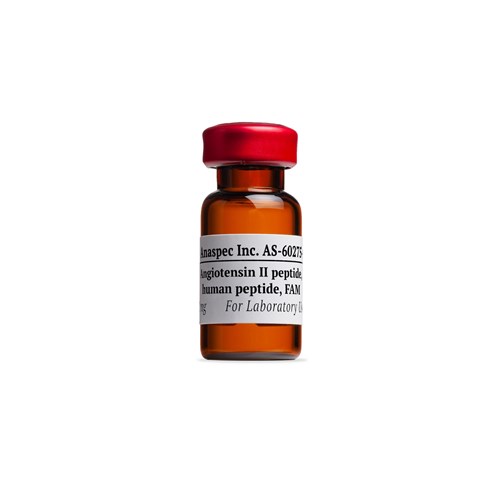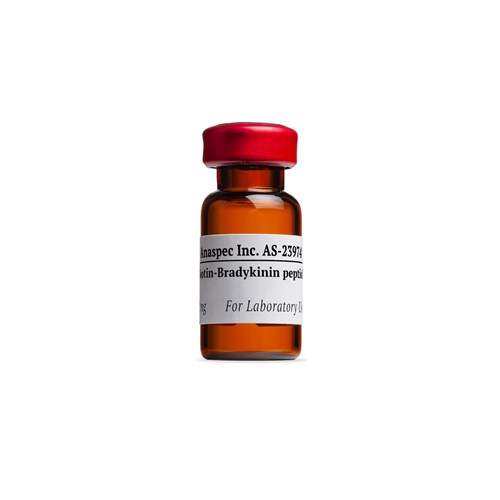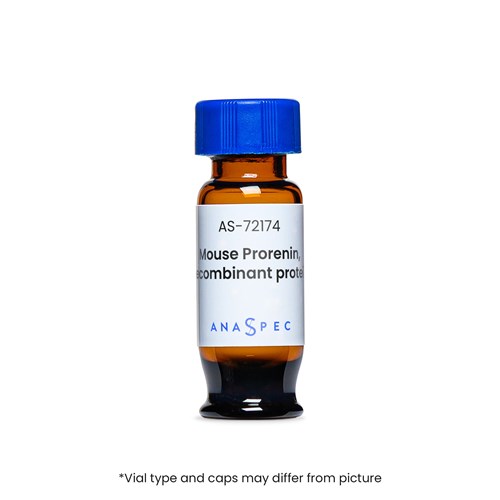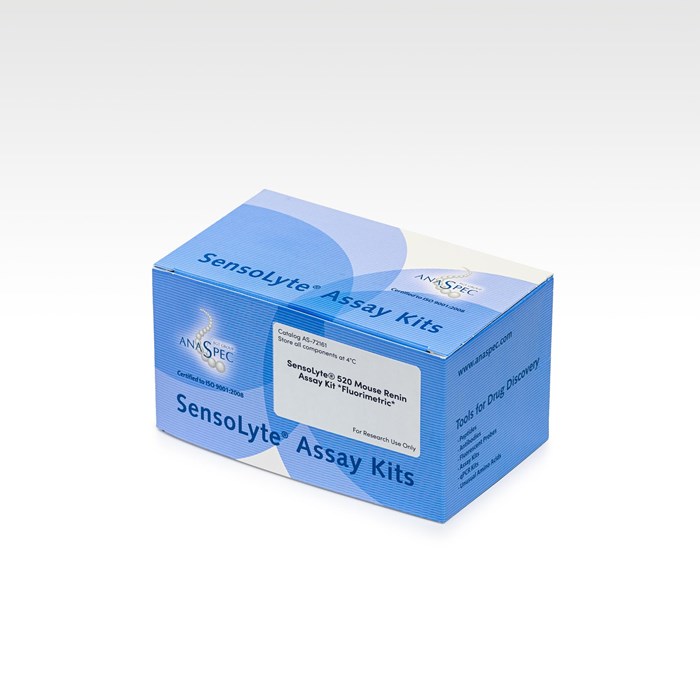SensoLyte® 520 Mouse Renin Assay Kit Fluorimetric - 1 kit
- Cat.Number : AS-72161
- Manufacturer Ref. :
-
Availability :
In stock
- Shipping conditions : Ice fees will apply
Alternative choices
Renin, a highly specific aspartyl protease, cleaves angiotensinogen, to yield angiotensin I. Angiotensin I is further converted into angiotensin II by ACE (Angiotensin Converting Enzyme). Angiotensin II constricts blood vessels leading to increased blood pressure. Discovery of new renin inhibitors for treatment of hypertension is a promising area of research.
The SensoLyte® 520 Mouse Renin Assay Kit provides a convenient assay for high throughput screening of renin inhibitors and for continuous assay of mouse renin activity using a 5-FAM/QXL™520 FRET peptide. In the FRET peptide the fluorescence of 5-FAM is quenched by QXL™520. Upon cleavage into two separate fragments by renin, the fluorescence of 5-FAM is recovered, and can be monitored at excitation/emission = 490/520 nm.
Specifications
| Packaging | |
| Kits components |
|
|---|---|
| Chemistry | |
| UniProt number |
|
| Properties | |
| Absorbance (nm) |
|
| Emission (nm) |
|
| Storage & stability | |
| Storage Conditions |
|
| Activity | |
| Application | |
| Biomarker Target | |
| Detection Method | |
| Research Area | |
| Sub-category Research Area | |
| Usage |
|
| Source | |
| Host | |
You may also be interested in the following product(s)



Citations
VDR Attenuates Acute Lung Injury by Blocking Ang-2-Tie-2 Pathway and Renin-Angiotensin System
Mol Endocrinol . 2013 Nov 06 ; 2116 27(12) | DOI : 10.1210/me.2013-1146
- J. Kong
Primary aldosteronism and impaired natriuresis in mice underexpressing TGFβ1
Proc Natl Acad Sci U S A . 2013 Mar 15 ; 5600 110(14) | DOI : 10.1073/pnas.1302641110
- M. Kakoki
Angiotensin II receptor blocker improves the lowered exercise capacity and impaired mitochondrial function of the skeletal muscle in type 2 diabetic mice
J Appl Physiol . 2013 Jan 17 ; 114(7) 844 | DOI : 10.1152/japplphysiol.00053.2012
- S. Takada
Single atom substitution in mouse protein kinase G eliminates oxidant sensing to cause hypertension
Nat Med . 2020 Mar 18 ; 18(2) 286 | DOI : 10.1038/nm.2603
- O. Prysyazhna
Influence of angiotensin II type 1 receptor-associated protein on prenatal development and adult hypertension after maternal dietary protein restriction during pregnancy
J Am Soc Hypertens . 2012 Aug 28 ; 6(5) 324 | DOI : 10.1016/j.jash.2012.07.001
- K. Tsukuda
Vitamin D receptor signaling in podocytes protects against diabetic nephropathy
J Am Soc Nephrol . 2012 Nov 02 ; 23(12) 1977 | DOI : 10.1681/ASN.2012040383
- Y. Wang
Viral transduction of renin rapidly establishes persistent hypertension in diverse murine strains.
Am J Physiol Regul Integr Comp Physiol . 2015 Jun 24 ; 309(5) R467 | DOI : 10.1152/ajpregu.00106.2015
- S. Harlan
High glucose induces trafficking of prorenin receptor and stimulates profibrotic factors in the collecting duct
Scientific Reports . 2021 Jul 05 ; 11 13815 | DOI : https://doi.org/10.1038/s41598-021-93296-4
- VR Gogulamudi
- et al
Beta-Arrestin1 Prevents Preeclampsia by Downregulation of Mechanosensitive AT1-B2 Receptor Heteromers
Cell . 2019 Jan 10 ; 176(1-2) 318 | DOI : https://doi.org/10.1016/j.cell.2018.10.050
- U Quitterer
- et al

